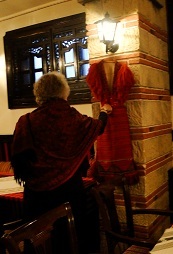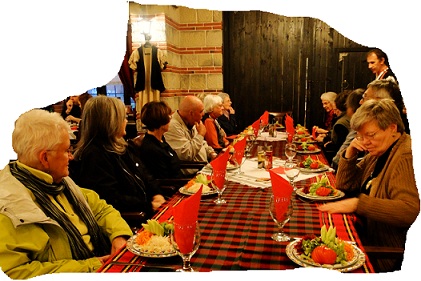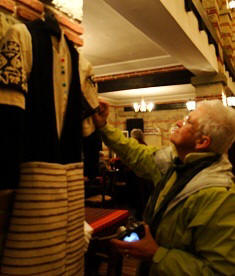![]()
![]()
![]()
Day 02 April 16,
2013 Tuesday
Istanbul - Skopje Macedonia
The morning call was at 5:00 AM.
the hotel had kindly provided us a full breakfast even that early in the
morning. Everyone was eager to get on the bus and may be catch up with
their sleep for another hour before we got to the airport on the Asian
side of Istanbul. But the bus driver was 10 minutes late. His delay woke
us all up. So when we got on the bus, we already started talking about
the politics of Turkey and all the changes Turkey had since 2002. Those
who had been to Turkey several times since then had noticed a dramatic
change. Meli's answer to Anita's question was like a political
commentary on the 7 o'clock news.
The airport formalities went smooth. The plane was on time. Pegasus Air lines did not serve food like many other airlines but Meli gave every one a bag of "borek" (cheese pastry) .We survived the short flight. When we arrived Skopje, the " Alexander the Great Airport " we were all eager to get started. But, unfortunately, we found out that Jo Ann's luggage was missing. After the usual lost luggage formalities, changing the money, using the restrooms, we headed off to Skpoje, the capital of Macedonia.
In 2011 , most of us, who are now on this tour, had visited Macedonia and fell in love with this country. When our guide from two years ago, Stefan, welcomed us on the bus with good literature and maps about Macedonia, we were really happy to see him and being back in Macedonia. The mountains surrounding the city were covered with snow but the nature along the road had already started celebrating the spring.
We started the tour at the
KALE, the fortress. The Roman inner walls of the fortress were
surrounded with the Ottoman castle, and the 20th century restoration was
trying to maintain the life of this 2000 year old construction. Looking
down to the Vardar river, we could see the new city built after the 1963
earthquake. On the opposite hill from where we were, at the same level
as the ancient fortress, there was another castle like building. We were
told that, this building was the largest American Embassy of the former
Yugoslavia.
Walking down hill, through the narrow streets of the old city, we arrived at our Kofte restaurant. The meatballs grilled on wood fire and served with onions looked very inviting when we saw them behind the smoke. The inviting smell was spreading into the whole neighborhood.
We had free time to be on our own for 45 minutes. Some enjoyed people watching while they were sipping their coffee at the restaurant, the others found things to shop. Especially the old man's leather shoe shop was popular.
We had found the Ethnographic museum in this city to be a very exciting, thrilling museum. Anita and Meli had decided to include Skopje to share their pleasure of learning about Macedonians and their incredible culture through this museum.
After lunch we walked through numerous jewelry shops, and buildings which are waiting to be restored to the Ethnographic museum. The Museum of Archaeology was being replaced to the new museum which is being built for at least two years since the last time we were in Macedonia the last time. However, there was a wonderful display of an icon collection.
The icons were lined up chronologically. The oldest was from the 11th Century , the newest was from the 19th Century. The colors, the techniques and the subjects of the icons were very different and interesting. Most of us thought that this was the best down to earth icon collection that we have seen.
One icon was showing the infant Jesus being crippled. We were told that this icon was made to honor the veterans of a war in the 17th century. St Nicholas looked like he could have been anybody's grand pa. The affectionate look on Mary's face when she is portrayed as hugging her son was very realistic.
The Ethnography Museum had an excellent display. But the physical condition of the museum was sad. The museum guide who obviously loved what he was doing and was very clear in his explanations sadly told us that our group was the only 2nd group that they had in that museum this year. We wondered how long would this museum can stay open with lack of attention from the state and from the visitors.
The ethnic dresses seemed like were mostly designed around warding off the evil. Most of them used silver of all forms, coins, necklaces, belts to ward off the evil. some dresses were crowned with " tree of life" for the same purpose. The banners used by the Christian families for the wedding ceremonies in the Ottoman era often had the symbol of the Ottoman empire, the star and crescent, along with the crosses. On our way to the bus we saw modern versions of the wedding dress makers and jewelers. They no longer were using silver nor beautiful embroidery.
When Stefan was telling us about St. Spas church, we were all using the last bit of energy we had left that day. We learned that the Ottomans were tolerant towards the non-Muslims. The churches and monasteries were built and restored during the 400 years of their rule. However, there was one condition for the construction of the churches; no church building could overcast a shadow on to a mosque. St. Spas's church like many others in the Balkans was built with half of the building buried in the ground. The walnut iconostasis was magnificent. the ceiling of the church was adorned with a very rare icon of God personafied. The old-man like God image was illuminated rather than with a hallow, with a triangle depicting the trinity.
We waited for the bus for a while. Then off to our hotel. Hotel Ambassador is centrally located a small hotel with very friendly staff. The rooms were nice, clean and quiet. We took 2 hours of rest while some of us enjoyed the beer in front of the large last supper icon.
Hotel Ambassador Pirinska street #38 1000 Skopje Macedonia Tel: + 3892 3121 383 Fax:3215729



The dinner was at the national restaurant Makedonska Kukja (Macedonian house). The building used to be a train station. It was very successfully restored to be a charming restaurant. The old costumes hanging every where attracted our fabric lovers. The service was fast, polite and efficient. The most wonderful thing was the food. We had fresh salad, excellent peppers filled with cheese and "tava" - ham and "kashkaval cheese" baked in small earthen pots. It was a great day. We are now ready to go to sleep.